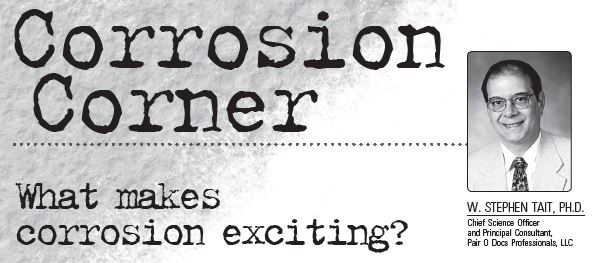Written on: October 1, 2012 by W. Stephen Tait
 Hello everyone. A lot of people find corrosion very exciting. For example, your marketing manager probably gets very excited about corrosion if it jeopardizes the timetable for a new product. In contrast, corrosion is exciting to engineers and scientists for significantly different reasons—reasons that don’t raise blood pressure.
Hello everyone. A lot of people find corrosion very exciting. For example, your marketing manager probably gets very excited about corrosion if it jeopardizes the timetable for a new product. In contrast, corrosion is exciting to engineers and scientists for significantly different reasons—reasons that don’t raise blood pressure.
There are many different types of corrosion and each has a unique way of initiating, and specific requirements for sustaining, the corrosion. Metal corrosion is a complex and an intriguing process involving a) changing the chemical state of a metal from its atoms to metal ions; b) electron transfer from the package metal to electrochemically active ions and molecules in your formula; c) ionic movement to and from the corrosion site to support the electron charge transfer and to balance electrical charge at the corrosion site and; d) transport of chemicals needed to support the corrosion reaction.
Polymer corrosion is the loss of the polymer’s ability to be a barrier as well as delamination of the polymer as blistering or large areas of polymer disbonded from the container metal or the aluminum foil. Polymer corrosion is also complex, involving a) diffusion of ions, formula ingredients and water into and through polymer coatings and laminate films; b) absorption of these materials at the polymer-metal interface and; c) breaking of metalpolymer bonds. These processes could also result in metal corrosion
under the polymer coating or laminate film.
Metal pitting corrosion requires an occluded area that restricts the diffusion of water; ions and formula ingredients into the occluded area, plus the diffusion of corrosion products out of the occluded area. Occluded areas in spray packaging include the crimps (or seams) between the a) container top and body; b) container bottom and body and; c) container curl and the aerosol valve.
Microenvironments form inside occluded areas, and these environments have chemical compositions that are significantly different from the composition of your formula. The microenvironment in an occluded area is often very corrosive. Corrosion is not a pure chemical reaction and typically does not follow the usual laws governing chemical reactions, such as the Arrhenius law. Consequently, the rates of metal and polymer corrosion typically are not accelerated by raising temperature. In other words, raising the storage test temperature 20 degrees does not double the rate of polymer and metal corrosion. Indeed, in some instance raising temperature often either causes, or arrests, spray package material corrosion that naturally occurs at room temperature.
Much like antibiotics, there is no one-size-fits-all corrosion inhibitor. There are some corrosion inhibitors, such as sodium benzoate, that effectively inhibit corrosion for a range of corrosive formulas. However, it doesn’t inhibit corrosion by all formulas. There has been a lot of statistical research conducted on corrosion in an effort to predict when and where it will occur. Unfortunately, none of this research has yielded models that predict the type of corrosion and its most likely location in spray packaging.
Corrosion testing is the most reliable way to help prevent and control corrosion. There are two types of corrosion tests: the traditional storage stability test and electrochemical testing. Storage stability tests require at least one year to complete and have a 2% to 7% risk that results will not be the same as the actual corrosion of commercially produced goods.
Electrochemical testing requires significantly less time to complete than a storage test and has a risk below 1% when the appropriate test parameters and data analysis protocols are used. However, the analysis of electrochemical data has a very steep learning-curve.
A large company corrosion database could be used to compare corrosion data from existing formulas with new formulas and line extensions to reduce the number of corrosion tests and the time needed for corrosion testing. An effective database should be very large and take years to build. However, such a database is a useful tool for reducing the risk of corrosion and moving new products and line extensions more quickly through development to market. Please send your questions /comments /suggestions to rustdr@pairodocspro.com. Back issues of Corrosion Corner are available on CD from ST&M. Thanks for your interest and I’ll see you in November.